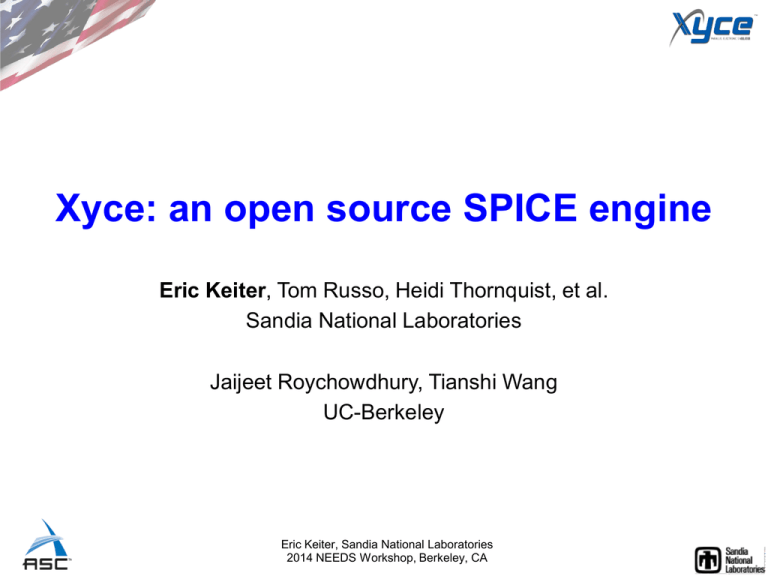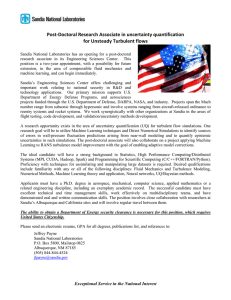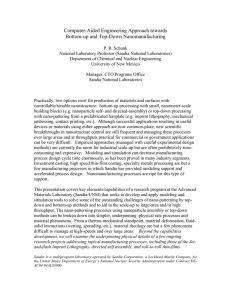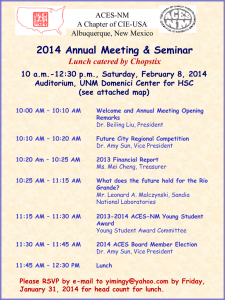Xyce: an open source SPICE engine
advertisement

Xyce: an open source SPICE engine Eric Keiter, Tom Russo, Heidi Thornquist, et al. Sandia National Laboratories Jaijeet Roychowdhury, Tianshi Wang UC-Berkeley Eric Keiter, Sandia National Laboratories 2014 NEEDS Workshop, Berkeley, CA Outline Xyce intro Xyce requirements Xyce design Object-oriented (C++ mostly) Spice-compatible But different than SPICE! Parallel implementation Analysis types (DC,Tran,AC, HB, MPDE, UQ) Open-Source (new, as of v6.0) ADMS model compiler ModSpec-Xyce Xyce supports most SPICE models (BSIM, EKV, etc) Eric Keiter, Sandia National Laboratories 2014 NEEDS Workshop, Berkeley, CA Parallel Circuit Simulator • Xyce: Massively Parallel circuit simulator: • • • • • Analysis types • • • • • • • Prompt Photocurrent Prompt Neutron Thermal Other, non-traditional models • • • • DC, TRAN, AC Harmonic Balance (HB) Multi-time PDE (MPDE) Model order reduction (MOR) Direct and Adjoint sensitivity analysis Uncertainty quantification (UQ) via Dakota. Sandia-specific models • • • • Distributed Memory Parallel (MPI-based) Unique solver algorithms SPICE-Compatible Industry standard models (BSIM, PSP, EKV, VBIC, etc) Neuron/synapse Reaction network TCAD (PDE-based) Xyce Release 6.0 • Open Source! • GPL v3 license http://xyce.sandia.gov Next release (v6.1) ~April 2014 Eric Keiter, Sandia National Laboratories 2014 NEEDS Workshop, Berkeley, CA Project Motivation: Why Xyce? • Comprehensive Test Ban Treaty (CTBT), 1993 • Advanced Simulation & Computing (ASC), 1995 • Qualification Alternatives to SPR (QASPR), 2005 • Offset lack of NW testing • Help qualify NW systems • Unique Requirements ➡ Differentiating capabilities – Unique models: Radiation Effects Radiation event – High fidelity: SPICE-level or higher – Large capacity: Massively-parallel – IP: Sandia owns it Radiation Effects Eric Keiter, Sandia National Laboratories 2014 NEEDS Workshop, Berkeley, CA Circuit response • Devices • Integrated circuit • Circuit Board Why Open Source? • • • • First open source release, v6.0 November 5, 2013. GPL license v3.0 Source and binary downloads available • xyce.sandia.gov • Next release (v6.1) ~April 2014. • Foster external collaboration • Feedback from wider community • Taxpayer funded, so encouraged to open source. Eric Keiter, Sandia National Laboratories 2014 NEEDS Workshop, Berkeley, CA SNL has six core technical capabilities 25 nm Microelectronics and Photonics 100) (100 Materials Science & Technology Computational & Informational Sciences 1000 1 2 6 10 15 3 7 11 4 8 12 16 5 9 13 600 14 17 Bioscience Engineering Sciences Pulsed Power Eric Keiter, Sandia National Laboratories 2014 NEEDS Workshop, Berkeley, CA 800 400 200 Hybrid-Hybrid solver result: 19x Speedup for Challenging IC Necessary for efficient simulation of a CMOS logic circuit: 1.6M total devices, ~2M unknowns Xyce w/ KLU solver takes ~ 2 weeks, w/ ShyLU solver takes ~ 1 day Strong scaling of Xyce’s simulation time and ShyLU linear solve time for different configurations of MPI Tasks X Threads per node. 7 Eric Keiter, Sandia National Laboratories 2014 NEEDS Workshop, Berkeley, CA CIS has a rich history in the development and maturation of high performance computing hardware and software technology CM-2 nCUBE-2 Paragon ASCI Red Red Storm Cplant iPSC-860 1989 1991 1993 1995 1997 1999 2001 2003 2005 1987 2007 Designed by Rolf Riesen, July 2005 2006 1988 1990 1992 1994 1996 1998 2000 2002 2004 R&D 100 Dense Solvers Gordon Bell Prize R&D 100 Gordon Bell Prize Allocator Patent World Record R&D 100 R&D 100 Meshing R&D 100 Teraflops Parallel Software Storage Trilinos R&D 100 Xyce Gordon Bell Prize SC96 Gold Medal Mannheim R&D 100 Networking SuParCup Signal Processing R&D 100 Patent R&D 100 World Record Karp Challenge Data Mining 3D-Touch 281 GFlops Aztec R&D 100 R&D 100 World Record Salvo Fernbach Meshing 143 GFlops Patent Patent Patent Award Parallel Software Paving Decomposition Eric Keiter, Sandia National Laboratories 2014 NEEDS Workshop, Berkeley, CA Transforming Design Capabilities then ~ 2001 PSpice circuit model: ~300 devices 2006 Xyce circuit model: 300K+ devices rad. model: empirical/behavioral rad. model: physics-based/built-in Eric Keiter, Sandia National Laboratories 2014 NEEDS Workshop, Berkeley, CA 201 2 model: Xyce circuit 40M+ devices Xyce Requirements Xyce started in 1999. Requirements/goals: • • • • • • SPICE-compatible Massively parallel Include special Sandia-specific physics models Useful to both sophisticated and unsophisticated users Object-oriented, modular (C++) Extensible, lots of developers Another way to put it: “Be the same as SPICE, but also be much better” “I never want to see the “Time step too small” error again” – Ken Marx, Sandia Electrical Analyst Eric Keiter, Sandia National Laboratories 2014 NEEDS Workshop, Berkeley, CA Why not use SPICE? SPICE: the original open-source simulator • de-facto standard To be useful: modular, well-structured, flexible • separated numerics, algorithms, models, I/O • simple, clean interfaces • short, easy to read, easy to modify i.e., not SPICE! Eric Keiter, Sandia National Laboratories 2014 NEEDS Workshop, Berkeley, CA excerpt from dioload.c (SPICE3) Sensitivity analysis code AC analysis code Transient analysis related code Eric Keiter, Sandia National Laboratories 2014 NEEDS Workshop, Berkeley, CA Why Modularity is Necessary Key to managing complexity • limits what each developer needs to know about the system • the “API” encapsulates rest of the simulator • Eg, to implement BSIM6.4, you don't need to know all about: • trapezoidal, Gear, etc. algorithms • shooting, harmonic balance, sensitivity, ... • Newton-Raphson, homotopy, ... Errors and mistakes reduced Eric Keiter, Sandia National Laboratories 2014 NEEDS Workshop, Berkeley, CA Modular Organization: The Big Picture Ckt structure descriptions (w behavioural extensions) Device model equations User commands Parser (sets up internal data structures for eqn engine/algorithms) Circuit Equation Engine (eg, MNA, Tableau, etc) User commands PNJ/FETLIM? Analysis algorithms: DC, AC, transient, HB, shooting, envelope, multi-time, noise, macromodelling, etc. Analysis outputs: system-level structures, macromodels Analysis results: waveforms, files, tables (arrows mean “needed for”) Eric Keiter, Sandia National Laboratories 2014 NEEDS Workshop, Berkeley, CA Analysis Algorithms: Structure dense & sparse matrix solution routines integration methods (BE, TRAP, Gear, etc) (arrows mean “needed for”) Newton-Raphson and Homotopy Krylov subspace, TBR methods; eigenanalysis, SVD routines 2, 3, etc. time scale multi-time/ envelope, including autonomous (time/freq domain formulations) DC transient AC stationary noise One-tone steady state including autonomous Multi-tone steady state including autonomous Cyclostationary/phase noise LTV/nonlinear macromodelling algorithms, including autonomous Eric Keiter, Sandia National Laboratories 2014 NEEDS Workshop, Berkeley, CA Xyce device hierarchy • Object-oriented design • devices derived from base objects • Hidden from devices: • Parallelism details • Analysis details • Each device responsible for providing f(x,t) and q(x,t) terms Eric Keiter, Sandia National Laboratories 2014 NEEDS Workshop, Berkeley, CA Xyce Analysis classes With proper code design, analysis types *should* be independent of device models (UQ) Reverse should also be true! Main difference between each of these is how f and q are handled. Eric Keiter, Sandia National Laboratories 2014 NEEDS Workshop, Berkeley, CA (UQ) Harmonic Balance • Expands state variables as a Fourier series; solves for the Fourier coefficients • Insensitive to widely spaced spectral components • Excellent for dealing with complex high-frequency passive (linear) components • Directly captures the large-signal quasi-periodic steady-state • Standard set of circuit equations: Circuit DAE: Approximate solution with Fourier expansion: Frequency domain equation: • Block linear system: • N=original system size • M=number of Fourier terms Eric Keiter, Sandia National Laboratories 2014 NEEDS Workshop, Berkeley, CA • Total size = N*M MPDE Analysis • Multi-time PDE (MPDE) • Useful for problems with widely differing time scales • Slow envelope • Fast periodic • Original DAE transformed into a PDE-like problem, where fast timescale solved all at once: Original DAE MPDE slow fast & periodic x(t ) = sin( 2πt ) sin( 2π 109 t ) xˆ (t1 , t 2 ) = sin( 2πt1 ) sin( 2π 109 t 2 ) x(t ) = xˆ (t , t ) Eric Keiter, Sandia National Laboratories 2014 NEEDS Workshop, Berkeley, CA DCOP Non-linear solution techniques • DCOP solution can be difficult • No initial guess! • Some circuits have multiple DC solns. • Need to find stable solution. • DCOP is initial condition to most analysis methods: • TRAN, AC, HB, etc “Hard” Problem • Homotopy: o Relax stiffness o continuation params o Obtain solution via continuation • Common examples (Xyce & SPICE) o Voltage source stepping o GMIN stepping “Easy” Problem • Less common (Xyce): o Pseudo-transient o MOSFET homotopy (see right) MOSFET continuation example * Figure 12 from, Jaijeet Roychowdhury and Robert Melville, “Delivering Global DC Convergence for Large Mixed-Signal Circuits via Homotopy/Continuation Methods” IEEE Trans. CAD of ICAS, vol 25, no 1, 2006. Eric Keiter, Sandia National Laboratories 2014 NEEDS Workshop, Berkeley, CA Model Order Reduction(MOR) • Model reduction: in a rigorous manner, generate a system of the same form, but smaller dimension, with input-output behavior approximately the same. • Very important for large linear networks, such as postlayout parasitics. • Several projection methods are implemented in Xyce. • Projection squashes matrices to smaller size QT A Q Eric Keiter, Sandia National Laboratories 2014 NEEDS Workshop, Berkeley, CA A^ Uncertainty Quantification (UQ) • Xyce has a number of capabilities to support uncertainty quantification (UQ) • Mostly these come via the DAKOTA framework. • General idea: given uncertainty on parameter inputs, how to estimate that on circuit outputs. • Most simulators support “brute force” approaches based on sampling. • Many much more sophisticated methods exist, including stochastic collocation methods, etc. Eric Keiter, Sandia National Laboratories 2014 NEEDS Workshop, Berkeley, CA ADMS-Xyce Verilog-A interface, via ADMS model compiler VBIC, Mextram, EKV, HiCUM, etc. Verilog-A: industry standard format for new models ADMS translates Verilog-A to compilable C/C++ code; API automatically handles data structures, matrices, tedious details. VBIC TRANSISTOR in VERILOG-A ADMSvbic.h ADMSvbic.C Run admsXyce Eric Keiter, Sandia National Laboratories 2014 NEEDS Workshop, Berkeley, CA Ready-to-compile C++ code ADMS-Xyce ADMS-converted models in Xyce: VBIC (the first model we did, only constant-phase so far) EKV (can't distribute thanks to NDA, so it's not in 6.0 open-source) PSP (version 103) BSIM-CMG 107 (only one of the many variants) FBH HBT_X version 2.1 FBH HBT_X version 2.3 (we were able to process it into Xyce, but dropped this one after discussions with Matthias Rudolph (convergence problems)) MEXTRAM (we don't support mextram, but the MEXTRAM verilog can be (and has been) processed by our ADMS back-end). MVS Silicon virtual source model from nanohub.com (processed last week in ADMS, not really tested yet) Eric Keiter, Sandia National Laboratories 2014 NEEDS Workshop, Berkeley, CA ADMS-Xyce What is unique about Xyce's use of ADMS? Sacado AD library: By using Sacado, we are able to do away with an enormous amount of "admst" code for computing derivatives (compare with ng-spice's or qucs ADMS back-ends). It is difficult to overstate how much back-end work this saves. Have added "$limit" support (simple mod to ADMS required to let "$limit" be recognized as a legal function, but otherwise all the work is in the back-end) Had to add some "attributes" for parameters and modules to provide certain metadata (descriptions, units, "model" vs. "instance", level number, whether it's a Q, M, Y device, etc.). Eric Keiter, Sandia National Laboratories 2014 NEEDS Workshop, Berkeley, CA ADMS Challenges ADMS back-ends are written in ADMST, a sort of XSLT superset. Xyce's linear system differs from SPICE so generating code for voltage limiting ($limit) is not as simple as generating a function call. ADMS has NO support for current branches. It generates datastructures representing the Jacobian resulting when all variables are nodal voltages, but you must do all the work yourself if you throw a branch current in the mix. Node collapse: since this has to happen at the time the device is instantiated (rather than the time its equations are evaluated), it is necessary to generate (separately from the rest of the evaluation) the parts of code needed to compute all the variables required to determine whether or not to collapse. Dynamic linking: this is on our roadmap, but hasn’t been done yet. Eric Keiter, Sandia National Laboratories 2014 NEEDS Workshop, Berkeley, CA ADMS Challenges not well suited for multi-physics domains no longer open-source even for electrical domain, doesn't support structures like internal current unknowns ADMS's website: “Noovela Consulting offers - at interesting rate - support to implement your compact models into spice simulators” future support uncertain written in XSLT difficult to work with or maintain e.g. took 6-7 years by Tom Russo (working off and on on it) even with ADMS already existing Eric Keiter, Sandia National Laboratories 2014 NEEDS Workshop, Berkeley, CA Multi-physics support in Xyce through ModSpec transistor-like eg, chemical sensors, “energy” nano-mechanical structures Verilog A SBML SUGAR translator translator translator nano-resonators optical interconnect lasers ModSpec C++ and .so files open and free dynamically loadable Eric Keiter, Sandia National Laboratories 2014 NEEDS Workshop, Berkeley, CA Model Development: Verilog-A → ModSpec → Xyce Already tested in MDE and Xyce High probability of success use model in Commercial Simulators Verilog-A model automatic translator binary release possible (IP protection) ModSpec compile Model standalone (C++ API) .so libraries (dynamically loadable) fast/efficient robust/efficient model deployed Test immediately model supported in Xyce (standalone) speed near native implementation (compiled C++ code) Eric Keiter, Sandia National Laboratories 2014 NEEDS Workshop, Berkeley, CA via ModSpec C++ API support (easy: example provided for Xyce) Xyce Summary • Mature code; under development for 14 years • Large regression test suite • Regular, formal code releases • Under active development • Open source GPL v3. • Modular object-oriented design • DAE form: • Quick, independent development of models and algorithms • Model support • • • • • Legacy spice models Non-electrical: neuron, reaction networks CMC models ADMS integration Mod-Spec integration Eric Keiter, Sandia National Laboratories 2014 NEEDS Workshop, Berkeley, CA Acknowledgements Xyce team xyce.sandia.gov Scott Hutchinson Tom Russo Heidi Thornquist Jason Verley Rich Schiek Ting Mei Dave Baur Sivasankaran Rajamanickam Trilinos team trilinos.sandia.gov Dakota team dakota.sandia.gov Eric Keiter, Sandia National Laboratories 2014 NEEDS Workshop, Berkeley, CA Thanks! Eric Keiter, Sandia National Laboratories 2014 NEEDS Workshop, Berkeley, CA Publications / Presentations Publications • “Electrical Modeling and Simulation for Stockpile Stewardship”, ACM XRDS, 2013 • “ShyLU: A Hybrid-Hybrid Solver for Multicore Platforms”, IPDPS 2012 • “Parallel Transistor-Level Circuit Simulation”, Simulation and Verification of Electronic and Biological Systems, Springer, 2011 • “A Parallel Preconditioning Strategy for Efficient Transistor-Level Circuit Simulation”, ICCAD 2009 Presentations • “Sparse Matrix Techniques for Next-Generation Parallel Transistor-Level Circuit Simulation” Heidi K. Thornquist, Parallel Matrix Algorithms and Applications 2012 • “Partitioning for Hybrid Solvers: ShyLU and HIPS” Erik G. Boman, Siva Rajamanickam, and Jeremie Gaidamour, Copper Mtn. 2012 • “Efficient Preconditioners for Large-Scale Parallel Circuit Simulation” Heidi K. Thornquist, SIAM Computational Science & Engineering 2011 • “Advances in Parallel Transistor-Level Circuit Simulation” Heidi K. Thornquist, Scientific Computing in Electrical Engineering 2010 • “Large Scale Parallel Circuit Simulation” Heidi Thornquist and Eric Keiter, Circuit and Multi-Domain Simulation Workshop, ICCAD 2009 Eric Keiter, Sandia National Laboratories 2014 NEEDS Workshop, Berkeley, CA


